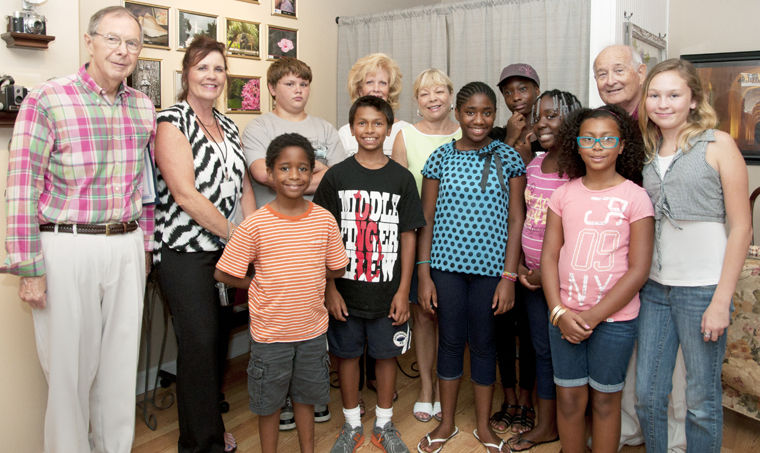
Strong role models are central to the development of children and adolescents, and for the past 40 years Youth Guidance mentors have acted in that capacity, offering positive guidance and friendship to tens of thousands of local at-risk children from single-parent, low income families.
Throughout most of its history, funding for Youth Guidance, which will celebrate its 41st birthday on Aug. 19, was provided by the county and augmented by donations. However, county dollars began tapering off several years ago, and direct cash assistance ended in October, 2013.
The agency now strictly relies on private donations and grants, including one funneled through the county-funded Children’s Services Advisory Committee. In October it will begin paying rent for the space they occupy; previously provided free by the county.
Faced with the challenge of doing more with less, the agency has restructured its operation with the development of a new Mentoring Academy.
Cathi Bates, a member of their very hands-on board of directors, is credited with concept.
“She saw what we were doing and saw where we wanted to go and she put it together,” says YG executive director Doug Borrie.
To develop the program, the agency hired Felix Cruz, who came on board in February in the newly created position of Mentoring Academy director. Cruz relocated from Miami where he worked with inner-city minority youth at ASPIRA of Florida, Inc.
The new approach offers a way to maximize resources through a matrix of small group mentoring, one-time group activities, one-on-one mentoring, and training.
“If I have 300 kids and have one-on-one mentoring I need 300 mentors,” Cruz explains. “With a group mentoring concept I can have 60 mentors and I still have every kid entering the program assigned a mentor. That then can translate into a one-to-one mentorship down the road.”
A critical aspect of the program is in-depth training for mentors, parents, volunteers and staff, who are all expected to go through the same training process.
“Before, we would get a volunteer come through the door and say ‘I want to volunteer.’ We do our background screening, match with a kid and they would go forth. There was no common approach to the mentoring.”
Now, after an orientation and background check, potential mentors are given an overview in a classroom setting to learn how the Mentoring Academy works.
“We take them through a mock presentation of what we do with the kids. So they get to experience first-hand, before they even meet a kid, what the mentoring approach will be. It’s a common thread,” Cruz explains.
Youth Guidance has also teamed up with the Big Brothers Big Sisters Mentoring Coalition, which was funded by an Impact 100 grant to provide Best Practice Mentor Training for those who wish it.
The enrollment process includes a formal application and interview, and children are given a Development Assets Survey, which measures the “internal strengths and external supports that influence adolescents’ success in school and in life.”
“That way we have a base line so that we can measure down the road. Research shows that for children who are succeeding, there are 30 developmental assets,” Cruz explains. “Children in poverty have 15, maybe 20. We’re trying to build those developmental assets up to 30.”
The agency would like to encourage additional community partners and volunteers to become involved in projects and activities in their areas of expertise or interest.
An example is the recent Photography Program led by Indian River Photography Club members Rene Donars and Dick Robertson. Children went out into the community alongside their mentors, taking pictures and learning about operation of the cameras. During the final week they had assistance framing their best shots, which were then put on exhibit for all to view the fruits of their labors.
Cruz says Board President Rebecca Hornbuckle will conduct a cooking program on preparing an entire family meal. A formal sit-down dinner at the end of the program will highlight proper table settings and etiquette.
“We want the parents to see what we’re doing so that they can reinforce the social skills we’re training them. The parents are learning, the child is learning, and the staff is learning some of these things as well. The core element to the program is mentoring. Everything we do, we want to have that element of mentoring. It’s not just an activity where the kids go and play.”
He also stresses that it is not an entitlement program.
“The children have to learn to earn. In order to stay in Youth Guidance the child has to get 36 credits per year; earned by attending a program. It’s important that they make commitments and that they attend each of these sessions so that they can earn these credits. A lot of these kids fail because they don’t learn or practice commitment, discipline.”
The Mentoring Academy is divided into six semesters, with year-round weekly programs, repetitive revolving programs, and once yearly programs.
The year-round Discovery series is general in nature, meant to foster character building, social interaction and building academic skills through a variety of activities. Revolving programs are more specific, such as cooking, photography, outdoor activities, music and art. Examples of once yearly programs would be SAT training, and building a float to march in the annual Christmas Parade.
“The feedback we’re getting from volunteers and mentors, the parents and our kids has been positive,” says Cruz. “The kids really liked the group concept. They have an opportunity to become familiar with a mentor before any one-to-one develops. This whole Mentoring Academy concept is drumming up a lot of excitement.”



